 |
||||
An Introduction to Lichens, and a Challenge
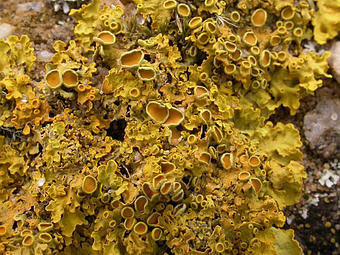 Xanthoria parietina showing apothecia (discs)
Xanthoria parietina showing apothecia (discs)
How about Xanthoria parietina, Lecanora muralis or Psilolechia lucida? Perhaps not, even though they are just as common and you probably see them every day. They may even occur in every tetrad in Bedfordshire; it would be good to have the evidence to prove this, so the challenge is to find each of these species and send me a record!
Get out of your armchair and go outside. Look up at your roof (or your neighbour's roof if you live in a thatched cottage). Can you see an orange lichen, perhaps on the ridge or along the edge? That is probably Xanthoria parietina. How about a grey-green lichen, perhaps circular with the middle missing, maybe under the television aerial (if you have one)? That one is probably Lecanora muralis.
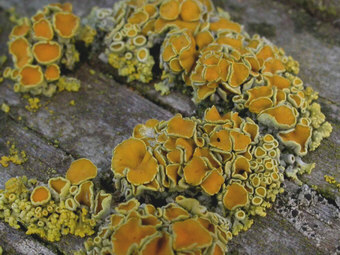 Xanthoria polycarpa
Xanthoria polycarpa
The best place to look for Xanthoria parietina is on a tree; perhaps the trunk of a well-lit Ash, Elder, Sycamore or Willow. What you are looking for is fairly large, wrinkly, leafy and bright orange (although it is greenish-grey when shaded).
Look in the centre of the lichen. Can you see some small orange discs (you may need a hand lens to see them)? If so, you have probably found Xanthoria parietina. However, if the lichen is on a twig rather than the trunk of the tree it may be Xanthoria polycarpa, which is much smaller than X. parietina and has so many discs that you can hardly see the rest of the lichen.
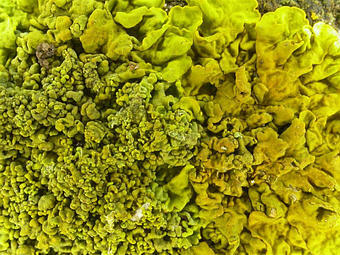 Xanthoria calcicola - warty isidia instead of apothecia
Xanthoria calcicola - warty isidia instead of apothecia
The orange colour is the protect the alga from strong sunlight, but in shaded habitats the alga needs all the light it can get, so the lichen is much lighter and may lack pigment entirely.
X. parietina is also common on roofs, wall tops (especially under trees), concrete fence posts or anywhere else where bird droppings may accumulate. However, a closely related species Xanthoria calcicola also grows here. The main difference from X. parietina is that there are few, if any apothecia. Instead, the centre of the lichen is covered with wart-like outgrowths called isidia. These are little packages containing both the fungus and the alga, which easily break off and will form a new lichen if they land somewhere suitable.
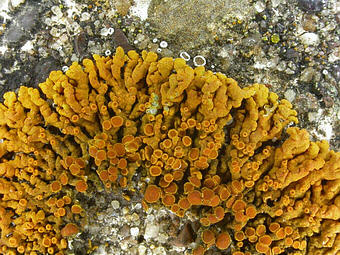 Xanthoria elegans - darker orange, long lobes
Xanthoria elegans - darker orange, long lobes
Another possibility on a wall, particularly on a concrete capping, is Xanthoria elegans. This is a much darker orange than X. parietina and it does not have the same wrinkly, leafy appearance. Instead it has long narrow lobes that adhere closely to the surface. There are usually many apothecia in the centre. It is usually somewhat smaller than X. parietina, but it is quite conspicuous.
Summary so far:
| Species | Habitat(s) | Colour | Appearance |
| Xanthoria parietina | Trees, roofs, walls, concrete posts. | Bright Orange
(greenish-grey in shade) | Large, wrinkly, leafy, with many discs in the centre. |
| Xanthoria calcicola | As X. parietina, but not on trees | As X. parietina | As X. parietina, but few, if any discs; warts instead. |
| Xanthoria polycarpa | Mainly on twigs | As X. parietina | Much smaller, discs cover the whole lichen. |
| Xanthoria elegans | Concrete wall tops | Dark Orange | Not leafy, long lobes, many discs in the centre. |
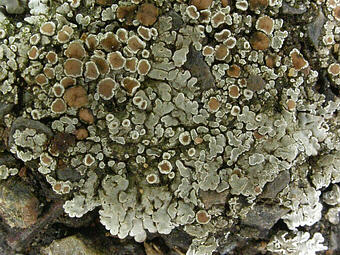 Well-developed Lecanora muralis
Well-developed Lecanora muralis
Find a likely looking large specimen and take a close look (with a hand lens if possible). Lecanora muralis usually consists of a many greenish or brownish grey "islands", each with a distinctly lighter margin. Larger specimens are usually roughly circular and the outside of lichen is leafy. In the middle of the lichen, there are numerous light brown apothecia, which are sometimes so crowded together that they appear angular instead of circular. In old specimens on roofs, the middle sometimes falls out.
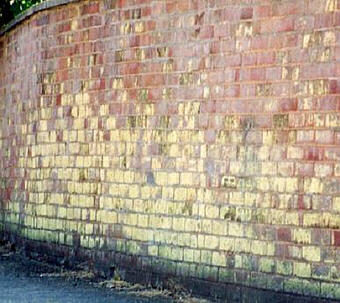 Psilolechia lucida
Psilolechia lucida- common on north facing brick walls
Psilolechia lucida is most common on north facing brick walls, often covering large areas. You may also find it one the north wall of your local church, but only if it is built of sandstone, or on sandstone headstones; most often on the east facing side. It is easily recognised at a distance by its colour, which is a vivid sulphurous yellow. Closer examination shows that it consists entirely of powder.
Psilolechia lucida is clearly a very different kind of lichen from Xanthoria parietina and Lecanora muralis, both in appearance and habitat. It thrives in cool, shady, damp places out of direct sunlight and rainfall. It only grows on vertical surfaces of brick or acid stone, where it does not receive much in the way of enrichment from bird droppings. It usually covers large areas, so it spreads very effectively, by the powder simply being spread by wind or rain.
When you have you found Xanthoria parietina, Lecanora muralis and/or Psilolechia lucida send me an email or write to me, telling me where you found it (with a grid reference if possible). Let's see if we can get a "dot" in every tetrad in Bedfordshire!
Bedfordshire County Recorder for Lichens
All images © Martin Butler